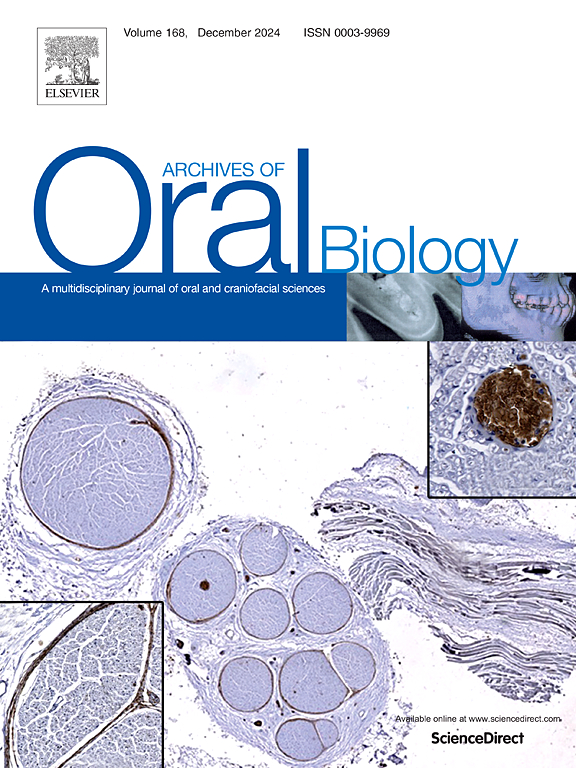Comparative analysis of antibacterial and antibiofilm potential of chemically- and green laser-produced gold and silver nanoparticles against dental pathogens
IF 2.1
4区 医学
Q2 DENTISTRY, ORAL SURGERY & MEDICINE
引用次数: 0
Abstract
Objectives
This study compared antibacterial and antibiofilm effectiveness of chemically (chem_) and pulsed laser ablation-synthesized (laser_) gold (Au) and silver (Ag) nanoparticles (NPs), namely chem_AuNPs, chem_AgNPs, laser_AuNPs, and laser_AgNPs, against four Streptococcus species (S. mutans, S. mitis, S. sanguinis, and S. gordonii), essential for cariogenic biofilm development.
Design
Nanoparticles were characterized for size and stability using dynamic light scattering (DLS) and transmission electron microscopy (TEM). Their antibacterial and antibiofilm activities were tested in microdilution and crystal violet assays, respectively. Ex vivo evaluation of the nanoparticles antibiofilm activity was performed against a four-species biofilm on enamel discs by quantifying CFU. Scanning electron microscopy was used to visualize the reduction in biofilm mass on enamel discs treated with laser_Au and Ag nanoparticles.
Results
TEM showed nanoparticle sizes ranging 5.89–18.49 nm. DLS revealed the stability of NPs colloid solutions, with ζ-potential approximately −30 mV over 21 days. All NPs exhibited strong antibacterial activity, with MIC values of 56.9–120.6 μg mL-1 for chem_AuNPs and 1.9–30.8 μg mL-1 for all the rest. The evaluation of NPs potential in biofilm prevention showed the following trend in activity: laser_AuNPs>laser_AgNPs>chem_AuNPs>chem_AgNPs. AuNPs, regardless of synthesis method, were as effective as the positive control (chlorhexidine-mouthwash) against the multispecies biofilm settled on enamel discs, while AgNPs were nearly twice as efficient.
Conclusions
AuNPs and AgNPs could be alternatives for managing cariogenic bacteria both planktonic and within biofilms. Laser_AgNPs, being more efficient than commercial mouthwash, seem to be the most valuable candidate.
化学和绿色激光制备的金、银纳米颗粒对口腔病原体的抗菌和抗生物膜潜能的比较分析。
目的:比较化学(chem_)和脉冲激光烧蚀合成(laser_)金(Au)和银(Ag)纳米颗粒(NPs),即chem_AuNPs、chem_AgNPs、laser_AuNPs和laser_AgNPs对四种链球菌(变形链球菌、米氏链球菌、血源链球菌和戈多氏链球菌)的抗菌和抗生物膜效果。设计:利用动态光散射(DLS)和透射电子显微镜(TEM)表征纳米颗粒的尺寸和稳定性。分别用微稀释法和结晶紫法测定其抗菌活性和抗生物膜活性。通过定量CFU对牙釉质盘上的四种生物膜进行体外抗生物膜活性评价。采用扫描电镜观察激光金、银纳米粒子对牙釉质盘生物膜质量的影响。结果:透射电镜显示纳米颗粒尺寸为5.89 ~ 18.49 nm。DLS显示了NPs胶体溶液的稳定性,在21天内,ζ电位约为-30 mV。所有NPs均表现出较强的抑菌活性,其中chem_AuNPs的MIC值为56.9 ~ 120.6 μ mL-1,其余NPs的MIC值为1.9 ~ 30.8 μ mL-1。NPs在生物膜预防中的活性评价显示:laser_AuNPs>laser_AgNPs>chem_AuNPs>chem_AgNPs。无论采用何种合成方法,AuNPs与阳性对照(氯己定漱口水)对沉积在牙釉质盘上的多物种生物膜的效果相同,而AgNPs的效果几乎是前者的两倍。结论:AuNPs和AgNPs可以作为控制浮游生物和生物膜内致龋细菌的替代方法。Laser_AgNPs比商业漱口水更有效,似乎是最有价值的候选者。
本文章由计算机程序翻译,如有差异,请以英文原文为准。
求助全文
约1分钟内获得全文
求助全文
来源期刊

Archives of oral biology
医学-牙科与口腔外科
CiteScore
5.10
自引率
3.30%
发文量
177
审稿时长
26 days
期刊介绍:
Archives of Oral Biology is an international journal which aims to publish papers of the highest scientific quality in the oral and craniofacial sciences. The journal is particularly interested in research which advances knowledge in the mechanisms of craniofacial development and disease, including:
Cell and molecular biology
Molecular genetics
Immunology
Pathogenesis
Cellular microbiology
Embryology
Syndromology
Forensic dentistry
 求助内容:
求助内容: 应助结果提醒方式:
应助结果提醒方式:


